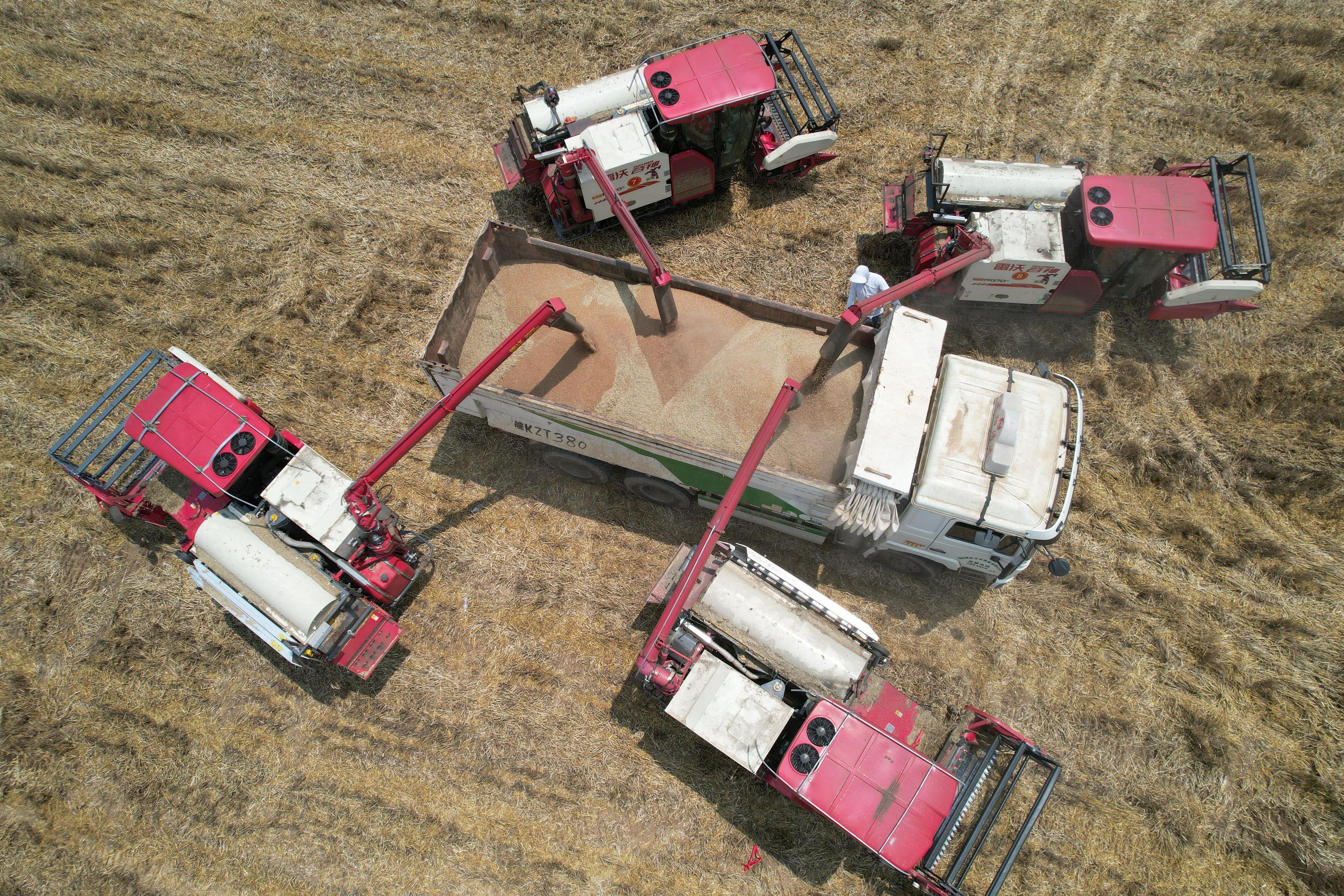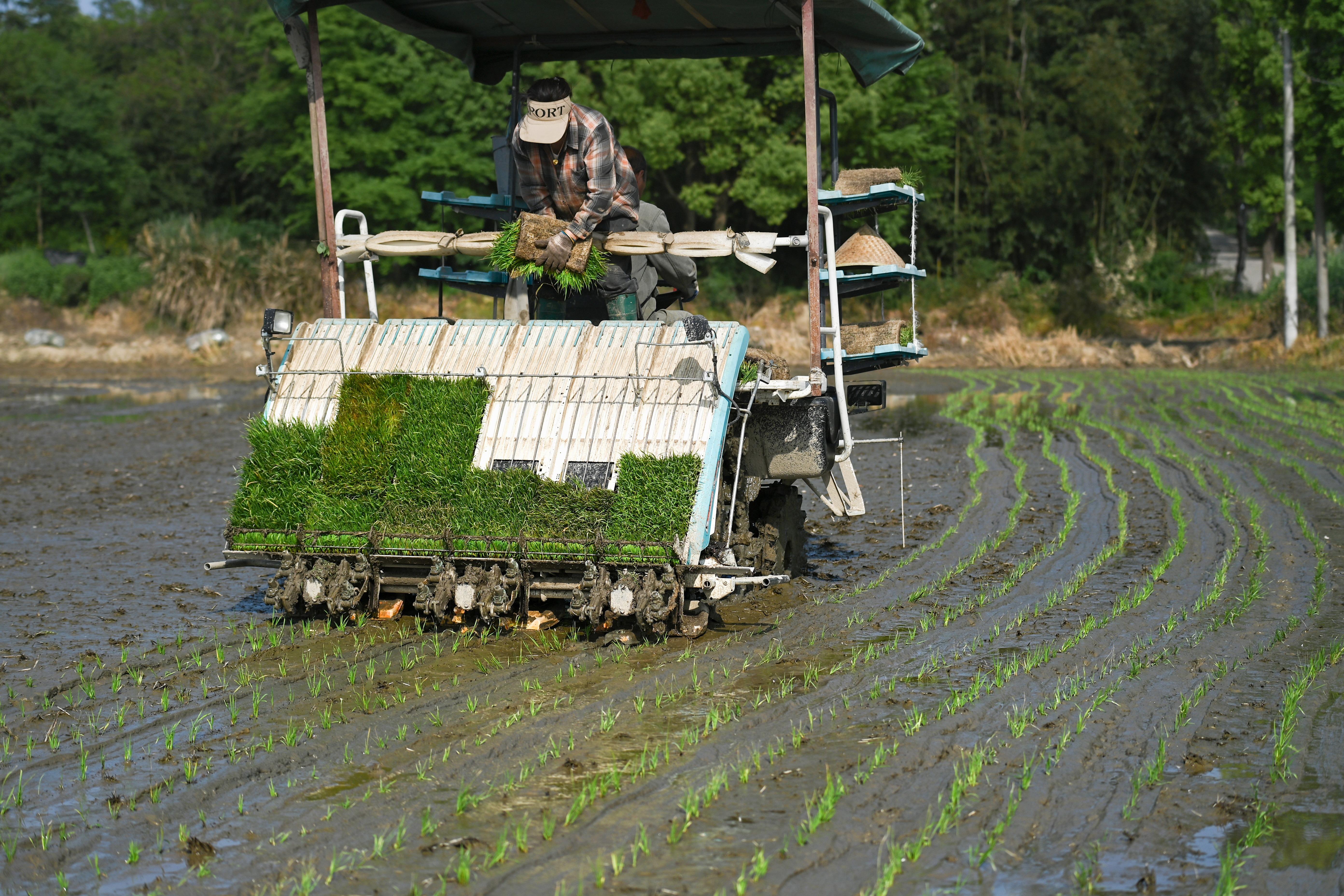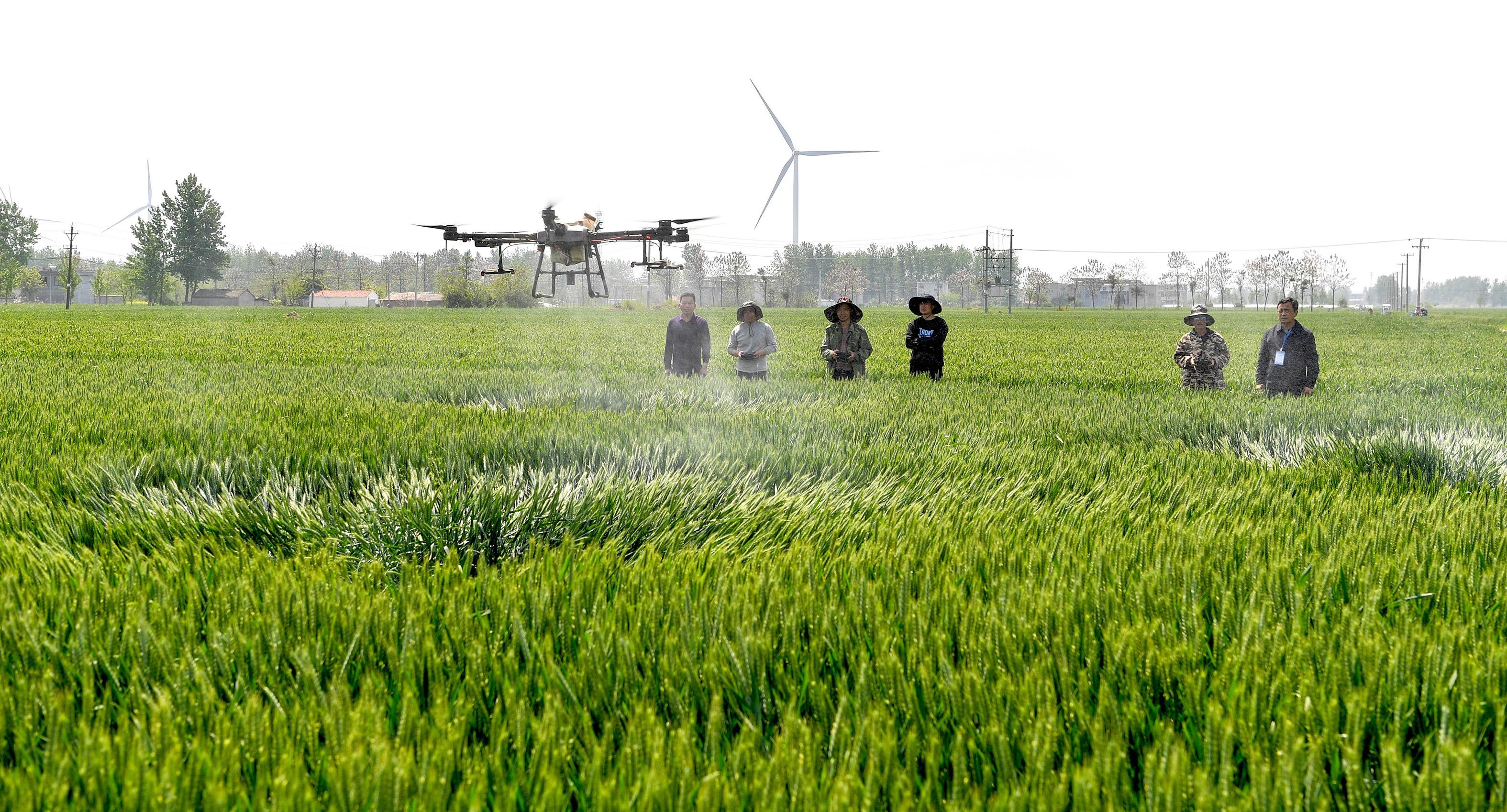Agriculture transformed as new business models introduced
 Harvesting machines load a truck with wheat in Fuyang, Anhui province, this month. (WANG BIAO / FOR CHINA DAILY)
Harvesting machines load a truck with wheat in Fuyang, Anhui province, this month. (WANG BIAO / FOR CHINA DAILY)
China is getting closer to its goal of developing all permanent basic cropland into high-standard cropland, which will be expanded to further benefit the agricultural sector.
The nation boasts about 128 million hectares of farmland, of which 103 million are permanent basic cropland.
Dong Yonghan, who lives in Dalu village of Hefei, Anhui province, has been busy leading his colleagues and villagers in harvesting wheat and planting sorghum on the 405 hectares of cropland.
Born in the 1970s, Dong said that harvesting and planting work is now much easier as cropland in the village had been transformed into high-standard field by 2021.
"The plots are now much bigger than before, along with the roads and irrigation networks," said Dong, secretary of the village committee of the Communist Party of China.
"The recent harvest only took us three days, as we used several machines," Dong said, adding that planting the broomcorn took just one week.
Five years ago, Dalu, which is administered by Changfeng county, had more than 12,000 plots of cropland. With two rounds of transformation work completed since 2018, the cropland has been divided into about 500 plots.
 Farmers plant rice seedlings in Hefei, Anhui, last month. (RUAN XUEFENG / FOR CHINA DAILY)
Farmers plant rice seedlings in Hefei, Anhui, last month. (RUAN XUEFENG / FOR CHINA DAILY)
In 2014, the central authorities released the General Principles for High-quality Cropland Construction, and amended them last year. The amended version states that China will have 80 million hectares of such land by 2030.
On Oct 16, the report to the 20th National Congress of the CPC stressed that the nation must reinforce the foundations for food security on all fronts.
The report said the total area of farmland in China should not fall below 120 million hectares, and all permanent basic cropland is expected to be gradually developed to a high standard.
The nation's food supply should remain firmly in its own hands, the report added.
In February, the No 1 Central Document, the first major policy document released annually by the CPC Central Committee and the State Council, stressed that the central government would implement a plan to transform all permanent basic cropland.
In the past five years, the area of high-standard cropland in China has risen by 30.4 million hectares, a State Council report stated earlier this year. The rate of mechanization for plowing, planting and harvesting crops rose from 67 percent to 73 percent.
 A rice transplanter works on high-standard cropland in Xuancheng, Anhui, in April. (MIAO ZIJIAN / FOR CHINA DAILY)
A rice transplanter works on high-standard cropland in Xuancheng, Anhui, in April. (MIAO ZIJIAN / FOR CHINA DAILY)
A report by Farmers' Daily said the nation will provide 300,000 hectares of new high-quality cropland this year, and further optimize 227,000 hectares of such land during this time.
Government data show that Anhui leads provincial regions in the transformation of high-standard cropland.
The province, which has 5.53 million hectares of cultivated land, will complete the provision of 4.5 million hectares of high-standard cropland by 2030, the provincial government said. More than 4 million hectares of such land had been provided in Anhui by the end of last year.
The provincial government's finance department said in March that Anhui would invest 10 billion yuan ($1.39 billion) on establishing new high-standard cropland this year.
The department said the standard funding from different levels of government in the province would be 37,500 yuan per hectare this year, and it would be raised to 45,000 yuan per hectare by 2025.
Meanwhile, the central government will continue to invest in providing high-standard cropland.
For example, to supply an additional 8,330 hectares of such land in Ma'anshan city, Anhui, the central authorities will allocate about 135 million yuan, while the provincial and municipal authorities will together invest about 113 million yuan, a recent news release from the municipal government stated.
 Wheat is harvested in Fuyang this month. (CHEN QUN / FOR CHINA DAILY)
Wheat is harvested in Fuyang this month. (CHEN QUN / FOR CHINA DAILY)
Higher standard
"In rural areas, when young people marry and start a family, their parents reallocate property, and more important, divide their farmland," Dong said.
"As a result, villagers' farmland plots are becoming smaller in size but are rising in number with growth of the population, although the total area of a village hardly increased after generations of cultivation," Dong said. In Dalu, the cropland is owned by more than 2,000 villagers, he added.
This area, located in the middle of the Yangtze and Huaihe rivers watershed, is home to undulating terrain.
In the past, rice was the most important crop in Changfeng county, and the villagers owned ponds to water the rice. Some ponds were owned by one family, while others were shared among several households.
"When there was a drought, irrigation was extremely hard, and numerous conflicts arose between the villagers over the use of water, Dong said.
Yang Xiaohu, an official at the county's bureau of agriculture and rural affairs, said a high-standard cropland construction project conducted through public bidding typically covers an area of several hundred hectares.
From 2012 to 2021, the county invested 2.4 billion yuan on 110 such projects in 187 villages with a total area of 64,000 hectares, the bureau said.
For each project, the government required that the number of plots should fall by no more than 70 percent. The bureau said that roads suitable for use by agricultural machinery should reach all plots that were transformed.
 Drones spread pesticides in a wheat field in Bozhou, Anhui, in April. (LIU QINLI / FOR CHINA DAILY)
Drones spread pesticides in a wheat field in Bozhou, Anhui, in April. (LIU QINLI / FOR CHINA DAILY)
New mode
In China, villagers own the right to use cropland, based on the requirements of the household contract responsibility system, a policy introduced in the early 1980s.
In 2021, about 267 hectares of cropland in Dalu were transferred to the State-owned Anhui Provincial State Farms Group for a new mode of business, while the remaining land was transferred to a number of villagers.
The group provides funding and technology, while the village, as a collective farming cooperative, is responsible for management. The villagers perform paid daily farm work.
Dalu villagers are paid an annual rent of 7,500 yuan per hectare by the group. In addition, 50 percent of the annual net profit goes to the group. Part of the remainder is distributed to the villagers as a dividend, while the rest is retained by the cooperative for purposes such as improving infrastructure in the village.
In 2019, in Hongqiao village, Yijing township, Changfeng, 380 hectares of high-standard cropland were entrusted to Kingfarm, a major company and modern agricultural service platform.
Kingfarm provides a one-stop service for the village, charging 6,900 yuan per hectare each year, with the aim of providing Hongqiao with an annual turnover of 10,500 yuan per hectare, the Changfeng agriculture and rural affairs bureau said.
The service provided by Kingfarm includes plowing, planting, disease prevention and pest control, harvesting and sale of produce.
Dong said: "As many villagers have moved to cities for work, they no longer have to worry about leaving their land idle. In addition to their salaries, they can also gain more income from these new business methods."
Last year, the cooperative in Dalu had an annual income of more than 10 million yuan — a sharp contrast to the 100,000 yuan it made in 2019.
Despite severe drought last year, Anhui reported grain output of 41 million metric tons, the fourth-highest among the 31 provincial-level regions on the Chinese mainland.
Provincial authorities said the provision of high-standard cropland was one of the major reasons for the good harvest.


